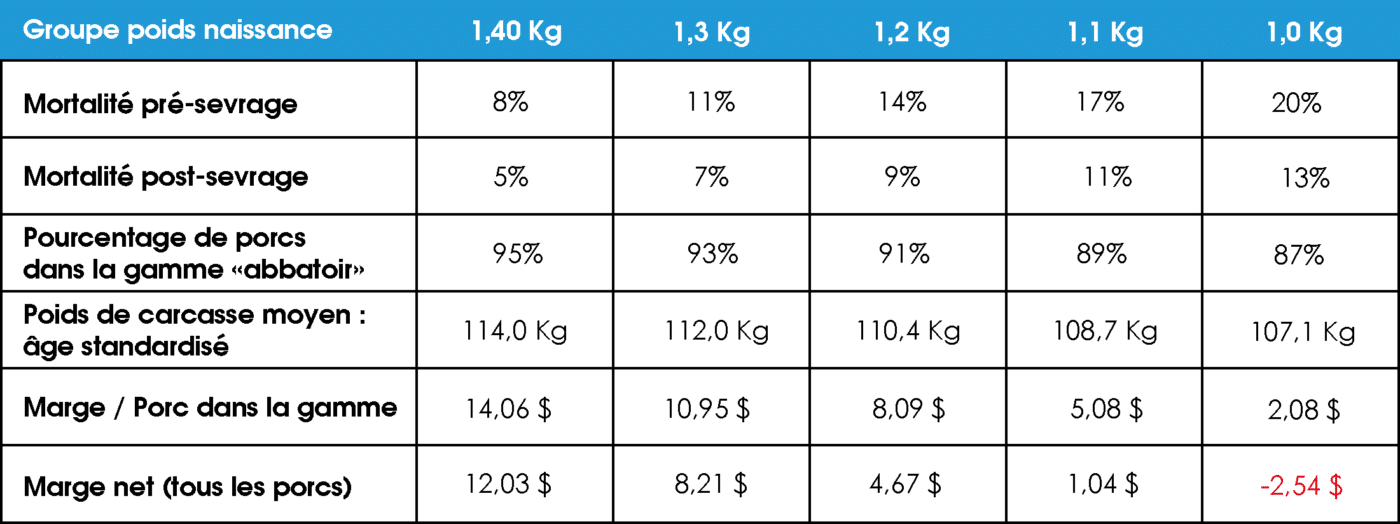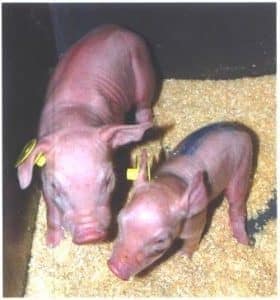Accueil › ID’info › Piglet quality at birth influences margin per pig
As we all know, the margin per pig can vary greatly depending on the market context, the demand from pork-consuming countries and supply and demand on the international market. But did you know that two piglets born on the same farm, from the same litter, can generate earnings expectations that vary from 1 to 15 times?
No, pig production profits are not like a lottery, but are always based on the rules and fundamentals of zootechnics linked to the animal world.
Yet this is the result of a very serious study conducted in the US (Iowa State University) by Dr John Mabry, a professor who published a study aimed at clarifying the impact of birth weight on profitability. His book ‘Les Voies du Profit’ is an illustration of this.
The same integration of pigs with the same rearing context for piglets from the same terminal cross.
A market carcass price of €1.55/kg. Feed costs of €295/tonne were used. The table below shows the relative performance and estimated benefit for each piglet birth weight class:

Source – thepigsite – Dr John MABRY 2015
The data is demonstrative of the impact of piglet birth weight on net margin per pig, ranging from $1 to $15 per pig.
These studies show a drop in performance for every 0.1 kg loss in birth weight.
1 – with 3% more pre-weaning mortality.
2 – with 2% more post-weaning mortality.
3 – with a 1.63 kg drop in selling weight
4 – with a net margin down by $3 per pig/100g birth weight.
Genetic improvement in numerical productivity has led to enormous gains in litter size over the last 30 years. This increase in total piglets born has sometimes been accompanied by a lesser improvement in the number of weaned piglets, or even more stillborn or mummified piglets.
The heterogeneity of birth weights is often a weak point, as are the maternal qualities of the sows, which show differences between genetic schemes. Uterine capacity has a strong influence on the number of piglets born alive and their birth weight, but this remains a difficult criterion to select on the farm.
At piglet level, full development through better organ maturity at birth is decisive for survival and performance. This trait is not completely correlated with birth weight, but also with nutritional deficiencies, impact on smooth muscle development and piglet vigour in the first few hours of life.

The IDENA PIG Service has focused its R&D efforts on the possibilities of supporting the genetic progress made on the TRUIES lines in partnership with various institutes and organisations.
The development of piglets in utero, from the ovulation and fertilisation phases through to farrowing, is vital to improving the quality and uniformity of piglets at weaning.
This is a major challenge in the field of animal nutrition, with a NUTRITION programme for sows based on FOLICO F. This speciality, incorporated into the GESTANTE feed, provides precursors for embryonic development by controlling hormonal, antioxidant and nutritional activities. Feeding sows with a high prolificacy potential is a topical issue for updating certain feed standards.
Breeders using FOLICO F have noted a better piglet survival rate: fewer losses in the 48 hours following farrowing.
More than 50% of farmers have noted an improvement in working conditions in the maternity unit, with fewer piglets being adopted, as FOLICO F helps to reduce differences in birth weight.
Breeders have adopted FOLICO F because they notice more vigorous piglets at birth, and above all less crushing because fewer stunted piglets. In sows with more than 17 live births, FOLICO F has increased birth weight by 70g/piglet. FOLICO F improves intra-uterine growth in piglets.
FOLICO F improves farrowing results – average gain of 0.6 piglets weaned/litter.
The IDENA PIG NUTRITION team is at your disposal to estimate the possible gains in different rearing situations.
Piglet quality must be at the centre of all interests, in particular by managing homogeneity and reducing the number of ‘stunted’ piglets that hyper-prolificity has unfortunately left in its wake. Piglet quality at birth improves profitability in pig farming.